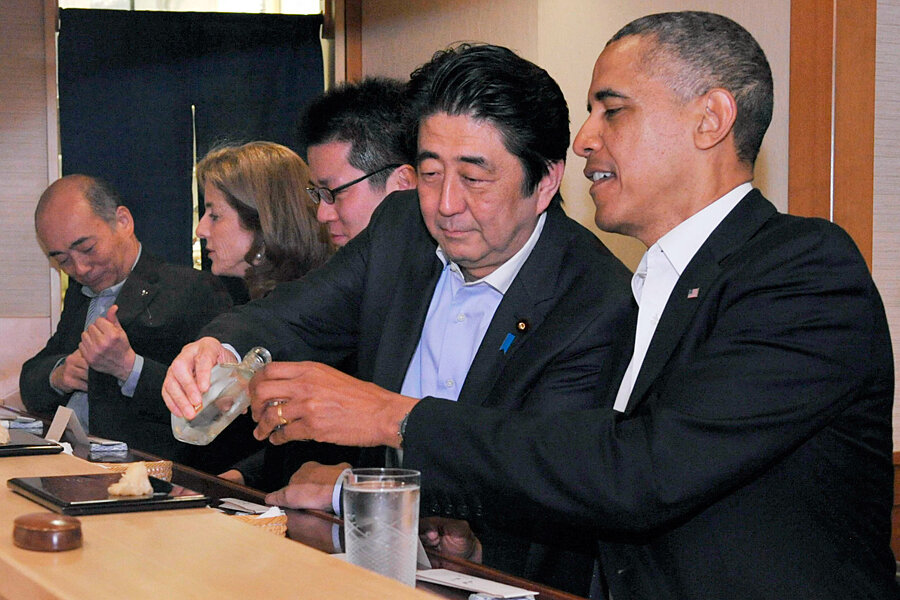Obama's Japan visit kicks off with dreams of sushi
| Tokyo
Tokyo’s sushi restaurants have been the setting for countless business deals. But for two special guests at Sukiyabashi Jiro on Wednesday evening, mouthfuls of melt-in-the-mouth tuna, squid, and octopus were the culinary backdrop to discussing urgent matters of regional security.
Soon after Air Force One touched down here, Barack Obama found himself in Tokyo’s upmarket Ginza district, tucked behind the counter of arguably the world’s best sushi restaurant with his Japanese host, Prime Minister Shinzo Abe.
Sukiyabashi Jiro’s modest size – it has just 10 seats – is inversely proportionate to its reputation.
Most Japanese, even those flush enough not to break into a cold sweat when presented with the bill, can only dream of eating there. The 19-piece special course, featuring a selection chosen by owner Jiro Ono, costs around $300, not including drinks.
Diners are expected to finish their meal in about 20 minutes – although Mr. Ono might have made an exception for the leaders of the world’s biggest and third-biggest economies.
Seats at the three-star Michelin establishment are often secured through introductions from trusted customers. It accepts reservations over the phone, but there's a waiting list: Don’t expect to feast on Ono’s exquisitely prepared fish any time before June.
Once inside, diners place their trust in Ono, who decides what they eat – and, crucially, what order they eat it in – while casting a critical eye over the counter to ensure that sushi etiquette is being observed to the letter.
Sources close to Prime Minister Abe said he thought a meal at the restaurant would be the ideal way for the leaders to build trust before they get down to the tricky business of North Korea’s nuclear weapons program and an increasingly assertive China.
Japanese and US leaders have a mixed history as dining companions, however. Former Prime Minister Junichiro Koizumi, the Elvis-loving hawk, and former President George W. Bush appeared to happily dine on flame-grilled hamburgers and Kobe beef during bilateral summits in 2003.
But Mr. Bush’s father will forever be remembered in Japan for vomiting over his host, then Prime Minister Kiichi Miyazawa, and then fainting during a state banquet in Tokyo in 1992. Had one of the Japanese delicacies offended his palate? Not at all, the senior Bush said later, blaming the episode on a 24-hour flu.
Long respected by fellow restaurateurs for his perfectionism and work ethic, Ono became something of a global celebrity in 2011 as the subject of the US-made feature length documentary, "Jiro Dreams of Sushi."
Despite its exclusivity and price tag, Sukiyabashi Jiro may prove to have been an inspired choice by Abe, given its casual, yet unmistakably Japanese atmosphere, and the relatively unfussy nature of the cuisine.
One Japanese TV network claimed the venue was suggested by Obama, who will experience a more formal style of Japanese dining when he sits down to a banquet with the emperor and empress on Thursday evening.
Regardless of who pushed for Jiro, some speculated the evening would be a subdued affair: Ono, still going strong at 88, is said to frown upon casual conversation among his patrons, preferring them to remain silent and, Zen-like, appreciate the flavor and texture of every last morsel.







